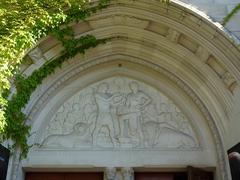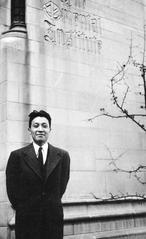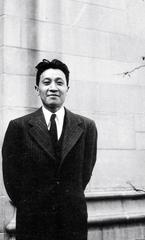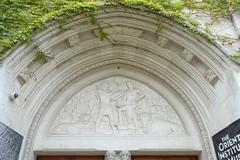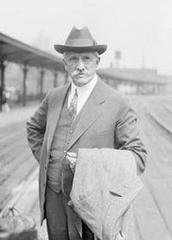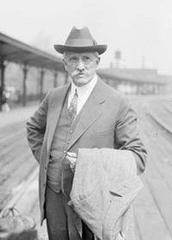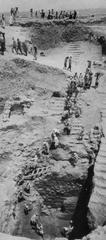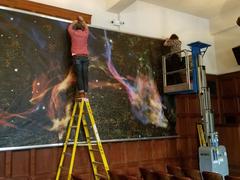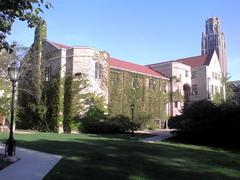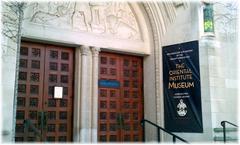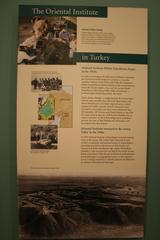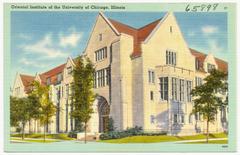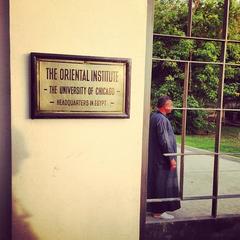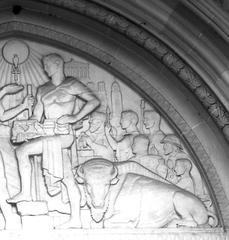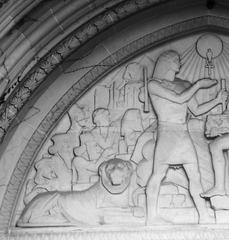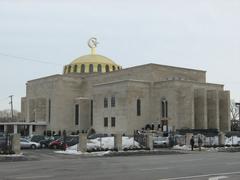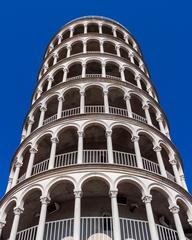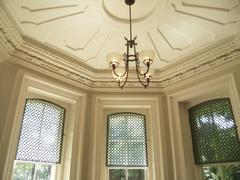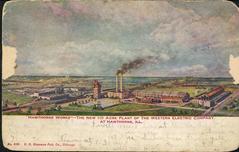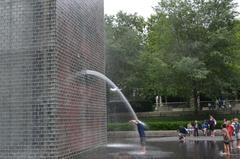
Institute For The Study Of Ancient Cultures, West Asia & North Africa
Guide to Visiting the Institute for the Study of Ancient Cultures, West Asia & North Africa, Chicago
Date: 17/08/2024
Introduction
The Institute for the Study of Ancient Cultures, West Asia & North Africa (ISAC), situated in the heart of Chicago, is a beacon of historical scholarship and public education. Originally founded as the Oriental Institute in 1919 by James Henry Breasted, a pioneering figure in the field of Egyptology, the institute has been at the forefront of archaeological research for over a century (University of Chicago). The establishment of ISAC was made possible through the visionary support of the University of Chicago and financial backing from notable philanthropists such as John D. Rockefeller Jr. The institute’s building, designed by Bertram Grosvenor Goodhue, stands as a testament to the architectural trends of the early 20th century, blending Gothic and Art Deco styles to create a space that bridges the past and the present (ArchDaily).
ISAC has significantly contributed to our understanding of ancient civilizations through groundbreaking excavations and scholarly publications. Major sites like Megiddo in Israel and Persepolis in Iran have provided invaluable insights into ancient societies, while the institute’s focus has expanded to include the study of ancient languages and the development of modern archaeological techniques (Oriental Institute, American Schools of Oriental Research). The institute’s name change in 2023 to the Institute for the Study of Ancient Cultures, West Asia & North Africa reflects its commitment to a broader and more inclusive representation of the regions it studies (Chicago Tribune).
Visitors to ISAC can explore an extensive collection of artifacts from ancient Egypt, Mesopotamia, Persia, and beyond, making it a must-visit destination for anyone interested in the ancient world. The museum offers a variety of educational programs, guided tours, and special events that provide deeper insights into ancient cultures. This guide will provide you with all the necessary information to plan your visit, including visiting hours, ticket information, and tips on nearby attractions.
Table of Contents
- Introduction
- History of the Institute For The Study Of Ancient Cultures, West Asia & North Africa
- Founding and Early Years
- Architectural Significance
- Major Excavations and Discoveries
- World War II and Post-War Era
- Technological Advancements and Modernization
- Recent Developments
- Contributions to Global Scholarship
- Educational Outreach and Public Engagement
- Preservation and Conservation Efforts
- Collaborative Projects and Partnerships
- Impact on Cultural Heritage Policies
- Future Directions
- Visitor Information: Plan Your Visit
- Nearby Attractions and Accessibility
- Frequently Asked Questions
- Conclusion
History of the Institute For The Study Of Ancient Cultures, West Asia & North Africa
Founding and Early Years
The Institute for the Study of Ancient Cultures, West Asia & North Africa, originally known as the Oriental Institute, was founded in 1919 by James Henry Breasted, a pioneering Egyptologist and historian. Breasted, who was the first American to earn a Ph.D. in Egyptology, envisioned an institution dedicated to the comprehensive study of ancient civilizations in the Near East. The University of Chicago supported his vision, providing the necessary resources to establish the institute (University of Chicago).
Architectural Significance
The institute’s building, designed by the renowned architect Bertram Grosvenor Goodhue, was completed in 1931. Goodhue’s design reflects a blend of modern and ancient architectural elements, symbolizing the institute’s mission to bridge the past and present. The building itself is a testament to the early 20th-century architectural movement, combining Gothic and Art Deco styles (ArchDaily).
Major Excavations and Discoveries
Throughout the 1920s and 1930s, the institute conducted several significant archaeological excavations. One of the most notable was the excavation at Megiddo in present-day Israel, which unearthed layers of ancient civilizations dating back to the Bronze Age. Another significant project was the excavation at Persepolis in Iran, which provided invaluable insights into the Achaemenid Empire (Oriental Institute).
World War II and Post-War Era
During World War II, the institute’s activities were significantly curtailed. However, the post-war era saw a resurgence in archaeological and scholarly activities. The institute played a crucial role in the development of modern archaeological techniques and methodologies. It also expanded its focus to include the study of ancient languages, publishing numerous dictionaries and grammars of ancient Near Eastern languages (American Schools of Oriental Research).
Technological Advancements and Modernization
In the latter half of the 20th century, the institute embraced technological advancements to enhance its research capabilities. The introduction of radiocarbon dating, satellite imagery, and digital databases revolutionized the field of archaeology. The institute also established the Epigraphic Survey in Luxor, Egypt, which has been instrumental in documenting and preserving ancient inscriptions (Epigraphic Survey).
Recent Developments
In recent years, the institute has continued to evolve, reflecting changes in the academic and geopolitical landscape. In 2023, the institute was renamed the Institute for the Study of Ancient Cultures, West Asia & North Africa, to better represent its broad geographical focus. This change underscores the institute’s commitment to inclusivity and its recognition of the diverse cultures that have shaped the region’s history (Chicago Tribune).
Contributions to Global Scholarship
The institute has made significant contributions to global scholarship through its extensive publications, including the “Oriental Institute Publications” and the “Studies in Ancient Oriental Civilization” series. These publications have disseminated groundbreaking research on ancient Near Eastern cultures, influencing generations of scholars worldwide (JSTOR).
Educational Outreach and Public Engagement
The institute has also prioritized educational outreach and public engagement. Its museum, which houses an extensive collection of artifacts from ancient Egypt, Mesopotamia, Persia, and other regions, serves as an educational resource for the public. The museum offers a variety of programs, including lectures, workshops, and guided tours, aimed at fostering a deeper understanding of ancient cultures (Oriental Institute Museum).
Preservation and Conservation Efforts
Preservation and conservation have been central to the institute’s mission. The Conservation Laboratory, established in the 1960s, has been at the forefront of developing techniques for the preservation of ancient artifacts. The lab’s work ensures that these invaluable pieces of history are preserved for future generations (Conservation Laboratory).
Collaborative Projects and Partnerships
The institute has established numerous collaborative projects and partnerships with institutions around the world. These collaborations have facilitated the exchange of knowledge and resources, enhancing the institute’s research capabilities. Notable partnerships include those with the British Museum, the Louvre, and various universities and research centers in the Middle East and North Africa (British Museum, Louvre).
Impact on Cultural Heritage Policies
The institute’s research has had a profound impact on cultural heritage policies globally. Its work has informed UNESCO’s guidelines on the preservation of cultural heritage sites and has contributed to the development of national heritage policies in several countries. The institute’s advocacy for the protection of cultural heritage has been particularly significant in conflict zones, where ancient sites are at risk of destruction (UNESCO).
Future Directions
Looking ahead, the institute aims to continue its pioneering research while adapting to the challenges of the 21st century. This includes leveraging new technologies such as artificial intelligence and machine learning to analyze archaeological data, as well as expanding its focus to include the study of climate change and its impact on ancient civilizations. The institute remains committed to its mission of advancing the understanding of ancient cultures and their relevance to contemporary society (Institute for the Study of Ancient Cultures).
Visitor Information: Plan Your Visit
Planning a visit to the Institute for the Study of Ancient Cultures? Here’s what you need to know:
- Visiting Hours: The museum is open Monday through Friday from 10 AM to 5 PM, and on weekends from 12 PM to 6 PM.
- Tickets: Admission is free, but donations are encouraged to support the institute’s ongoing research and public programs.
- Guided Tours: Guided tours are available and can be booked in advance through the institute’s website.
- Special Events: Check the institute’s calendar for special events, lectures, and workshops that might coincide with your visit.
Nearby Attractions and Accessibility
While you’re visiting, consider exploring other nearby attractions such as the University of Chicago campus and the Museum of Science and Industry. The institute is wheelchair accessible, and there are parking facilities available for visitors.
Frequently Asked Questions
Q: How do I get to the Institute for the Study of Ancient Cultures?
A: The institute is located on the University of Chicago campus and is easily accessible by public transportation or car.
Q: Can I take photographs inside the museum?
A: Yes, photography is allowed, but flash photography and tripods are prohibited to protect the artifacts.
Q: Are there any dining options nearby?
A: Yes, there are several dining options within walking distance of the institute, including cafes and restaurants on the University of Chicago campus.
Stay Updated: Follow Us for More Insights and Updates
Stay connected with the Institute for the Study of Ancient Cultures by following us on social media and checking our website for the latest news and updates. Download our mobile app Audiala for an enhanced visiting experience and more insights into our ongoing research.
Conclusion
The Institute for the Study of Ancient Cultures, West Asia & North Africa (ISAC) serves as a vital link between the past and the present, offering visitors a unique opportunity to explore the rich tapestry of ancient civilizations. Through pioneering research, significant archaeological discoveries, and extensive educational outreach, ISAC has cemented its place as a global leader in the study of ancient cultures. The institute’s commitment to preservation and conservation ensures that future generations will continue to benefit from its invaluable contributions to global scholarship (UNESCO).
As you plan your visit to ISAC, take advantage of the museum’s comprehensive offerings, from guided tours and special exhibits to its extensive collection of artifacts from ancient Egypt, Mesopotamia, and beyond. The museum’s location within the University of Chicago campus also provides the perfect opportunity to explore other nearby attractions, making for a rich and fulfilling cultural experience. Stay connected with ISAC through their website and social media channels for the latest updates and developments. Your visit to ISAC will not only deepen your understanding of ancient cultures but also help support the institute’s ongoing efforts to preserve and study the legacies of these remarkable civilizations. Download the Audiala app for an enhanced visiting experience and more insights into ISAC’s ongoing research.
Audiala2024
References
- University of Chicago. (n.d.). https://www.uchicago.edu
- ArchDaily. (n.d.). https://www.archdaily.com
- Oriental Institute. (n.d.). https://oi.uchicago.edu
- American Schools of Oriental Research. (n.d.). https://www.asor.org
- Chicago Tribune. (2023). https://www.chicagotribune.com
- UNESCO. (n.d.). https://www.unesco.org


